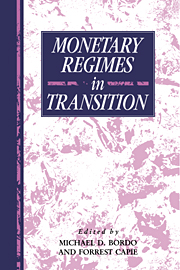Book contents
- Frontmatter
- Contents
- List of figures
- List of tables
- List of contributors
- 1 Introduction
- Part I Commodity money standards in transition
- 2 The scramble for gold: monetary regime transformation in the 1870s
- 3 The Latin Monetary Union and the emergence of the international gold standard
- 4 Greenback resumption and silver risk: the economics and politics of monetary regime change in the United States, 1862–1900
- Part II Successful and unsuccessful adherence to the gold standard
- Part III Wartime upheaval and postwar stabilization
- Part IV Perspectives on monetary regimes
- Index
2 - The scramble for gold: monetary regime transformation in the 1870s
Published online by Cambridge University Press: 05 May 2010
- Frontmatter
- Contents
- List of figures
- List of tables
- List of contributors
- 1 Introduction
- Part I Commodity money standards in transition
- 2 The scramble for gold: monetary regime transformation in the 1870s
- 3 The Latin Monetary Union and the emergence of the international gold standard
- 4 Greenback resumption and silver risk: the economics and politics of monetary regime change in the United States, 1862–1900
- Part II Successful and unsuccessful adherence to the gold standard
- Part III Wartime upheaval and postwar stabilization
- Part IV Perspectives on monetary regimes
- Index
Summary
Introduction
Economists and political scientists have long interested themselves in the regimes that govern economic and political systems. Both have become interested in regimes as a set of policy tools, institutions, and norms which organize political and economic relations into orderly patterns. An encompassing definition is found in Krasner (1982, p. 185): “principles, norms, rules, and decision-making procedures around which actor expectations converge in a given issue-area.” More recent scholarship has shown greater emphasis on how regimes are formed and transformed. Disciplinary parochialism has, however, fragmented the study of regime formation and transformation. Economists have been wont to take an apolitical approach to regimes: of principal interest have been the relative efficiency of competing institutional structures, and the changes in economic relations as catalysts for institutional change. Political scientists have been limited in the opposite direction: approaching regime change and formation as necessarily a political phenomenon. Regimes form and are transformed through the exercise of power or changes in political power structures.
This study takes a more integrated approach in considering the formation of the classical gold standard as the resultant of a prevailing mode of transformation in domestic monetary standards during the 1870s. Beginning with the Reichstag's mandate to make the gold mark the basic unit of account and restrict the minting of territorial silver coin in Germany in 1871, the transition from bimetallic and silver standards to a gold standard represented a compelling trend in the monetary systems of developed nations in the 1870s. Following Germany's lead, Norway, Denmark, and Sweden signed a convention in December 1872 instituting a gold standard in each nation, with silver and bronze coinage as subsidiary (i.e., token coin).
- Type
- Chapter
- Information
- Monetary Regimes in Transition , pp. 15 - 67Publisher: Cambridge University PressPrint publication year: 1993



